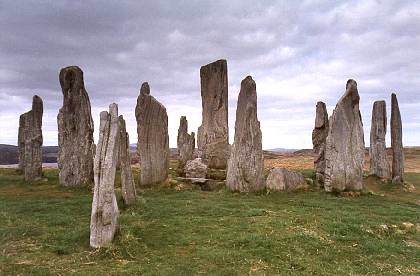Guardian of the Cairn
(Created page with "The Guardian of the Cairn is an Imperial title established by the Imperial Senate during Autumn 378YE. The position of Guardian ...") |
No edit summary |
||
| Line 1: | Line 1: | ||
{{CaptionedImage|file=Standing Stones of Callanish (Callanish I) (9605427).jpg|title=Photograph is the Callanish Stones in Lewis, Scotland|caption=The lonely stones of Sylvihrafn.|align=right|width=500}} | |||
The Guardian of the Cairn is an [[Imperial title]] [[Construct Sylvihrafn Crystal Henge|established]] by the [[Imperial Senate]] during Autumn 378YE. The position of Guardian is a sinecure, requiring minimal responsibility but offering a regular income of crystal mana. | The Guardian of the Cairn is an [[Imperial title]] [[Construct Sylvihrafn Crystal Henge|established]] by the [[Imperial Senate]] during Autumn 378YE. The position of Guardian is a sinecure, requiring minimal responsibility but offering a regular income of crystal mana. | ||
| Line 27: | Line 28: | ||
The henge itself is reasonably old; the founders of the Hold of Hrafnar often performed magical rituals here. When the [[Thule]] barbarians conquered the Skogei Glens, they continued this practice themselves - there is some evidence that several [[enchantment|enchantments]] designed to assist the invading armies originated among the stones and cairns. | The henge itself is reasonably old; the founders of the Hold of Hrafnar often performed magical rituals here. When the [[Thule]] barbarians conquered the Skogei Glens, they continued this practice themselves - there is some evidence that several [[enchantment|enchantments]] designed to assist the invading armies originated among the stones and cairns. | ||
The ring consists of | The ring consists of thirteen standing stones, around and between which are scattered low cairns of carved rocks. The stones are intricately threaded with mithril designs that denote the history of the battles with the Thule in Skarsind - both the recent invasion and liberation, and older conflicts stretching back to the dawn of Wintermark. The stones "draw up" mana flows from deep underground, and the crystals produced form on and around the rocky cairns. The crystals gathered here have a distinctive silvery tinge, that the a few [[Wintermark_culture_and_customs#Art_and_history|scops]] have claimed makes them resemble tears. | ||
[[Category:Imperial Titles]] | [[Category:Imperial Titles]] | ||
[[Category:Urizen]] | [[Category:Urizen]] | ||
Revision as of 11:38, 10 July 2015
The Guardian of the Cairn is an Imperial title established by the Imperial Senate during Autumn 378YE. The position of Guardian is a sinecure, requiring minimal responsibility but offering a regular income of crystal mana.
Responsibilities
The Guardian has no particular responsibilities; they simply receive a bounty of crystal mana from the Sylvihrafn in Skarsind. If the Henge were to be threatened in any way, it would be the responsibility of the Guardian to deal with those threats.
Powers
As a sinecure, Sylvi Hrafn Crystal Henge provides it's Guardian with no particular powers; rather they receive an income of 9 crystal mana each season.
Selection
The Guardian is a national position appointed by the Senate in Wintermark. Under normal circumstances it will be appointed by unanimous vote of the Wintermark senators.
Because this is a national position, the title can only be held by a citizen of Wintermark.
Removal
The Guardian has tenure and serves until they die, step down or are revoked.
The Guardian can be revoked by the Wintermark national assembly, the the General assembly or the Assembly of Nine.
History
The stones and cairns that make up the crystal henge are quite old, but their use as a source of crystal mana is very recent. Construction and expansion began in late-autumn 378YE and was finished just in time for the Winter Solstice. The stones themselves were augmented with polished mithril, and several cairns were adjusted to help direct flows of subterranean mana toward them.
At the Winter Solstice, Warrior-Thane Thanmir Hrafnar was appointed the first Guardian of the Cairn.
Sylvihrafn
The crystal henge of Sylvihrafn stands in Skarsind near the Hold of Hrafnar in the north-eastern Skogei Glens. The hall and the henge alike overlook the dark forests of Varushkan Miekarova. It is named for the late Sylvi Hrafn who helped raise the funds to have the henge restored, but sadly perished before she could see the work completed. Originally it was named Sylvi Hrafn Crystal Henge, but as is the way in Wintermark the name was quickly shortened to Sylvihrafn.
The henge itself is reasonably old; the founders of the Hold of Hrafnar often performed magical rituals here. When the Thule barbarians conquered the Skogei Glens, they continued this practice themselves - there is some evidence that several enchantments designed to assist the invading armies originated among the stones and cairns.
The ring consists of thirteen standing stones, around and between which are scattered low cairns of carved rocks. The stones are intricately threaded with mithril designs that denote the history of the battles with the Thule in Skarsind - both the recent invasion and liberation, and older conflicts stretching back to the dawn of Wintermark. The stones "draw up" mana flows from deep underground, and the crystals produced form on and around the rocky cairns. The crystals gathered here have a distinctive silvery tinge, that the a few scops have claimed makes them resemble tears.
